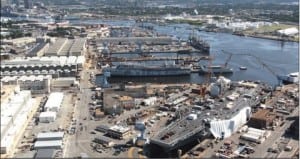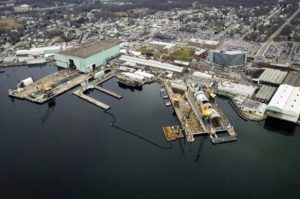A Navy official this week outlined the submarine community’s challenges in needing to hire over 100,000 new workers over the next decade to maintain and improve shipbuilding and sustainment.
“In the submarine community, we have a couple of key spots where we are hundreds to thousands of people short. If you go across our 17,000 suppliers that we’ve mapped with data analytics…We have to hire and retain a better rate than we are right now. About 100,000 skilled workers in the next 10 years. That’s just for the submarine new construction demand signal, does not include submarine sustainment,” Matt Sermon, Program Executive Officer for Strategic Submarines, said during a panel discussion Monday at the American Society of Naval Engineers’ Technology, Systems and Ships Symposium.

He noted that 100,000 positions includes all the sub-tiers of the submarine supply chain, with shipbuilders themselves only making up about one third of that number. It also only includes the current plan to produce one Columbia-class ballistic missile submarine and two Virginia-class attack submarines per year and not additional partnership opportunities like the AUKUS agreement to help Australia build and acquire nuclear-powered attack submarines in the coming decades.
Sermon said the Navy expects to have the number from models to rise to about 130,000 when it added submarine sustainment via both public and private shipyards, “but that model is not is not complete yet.” He said the final numbers should be ready in about three months,
Sermon argued the Navy and the industrial base community has to work on a war for talent to staff these positions in the coming years.
‘You’ve got to do that through a handful of different ways. You have to win a larger market share of the conventional “kids” coming out of school, that means connecting with them,” Sermon said.
He said the community has to explain and leverage the importance of performing these kinds of national security manufacturing workforce jobs in a way the community has not had to do in decades.
Sermon compared it unfavorably to the 1980s naval buildup that did not require this kind of attention, because the Cold War “existential threat that existed then.” Instead, the submarine industrial community has to rebuild the connection to community and the importance of building these vessels.
Sermon described four other main submarine construction issues.
One is a surge in demand despite fragile market sectors that need more stable demand for companies to make longer term investments. He said there is progress on this front, “but not enough and not fast enough.”

This matches comments from high level Navy officials earlier this month.
Earlier in January, Chief of Naval Operations Adm. Mike Gilday said the Virginia-class submarine builders are not building at the planned two-year build rate, but only at around 1.2 submarines per year (Defense Daily, Jan. 11).
Gilday said the fiscal year 2023 defense authorization and appropriations bills should be incentive enough for now to the shipyards to improve stability and production rates.
Sermon said the other three submarine construction issues are managing a manufacturing technology revolution requiring faster movement, particularly using metallic additive manufacturing; weaponizing data analytics to get more proactive and less reactive on sub-tier issues in the supply chain; and creating a sort of diplomat to work with the industrial base and improve mentoring as well as engineering trade pipelines.
He said part of the solution is keeping the Navy more closely in the loop in production challenges to minimize surprise after the fact.
“How do we not get surprised by hiccups, be they labor safety, financial obsolescence, foreign investment, whatever they are? How do we not be surprised by those things by using public source data? How do we better understand and make decisions? Quite frankly, how do we better leverage AI and data analytics, to not make it so hard to plan maintenance and to plan new construction work?”